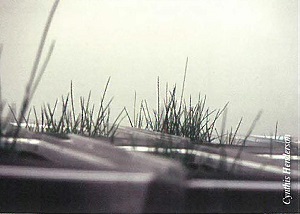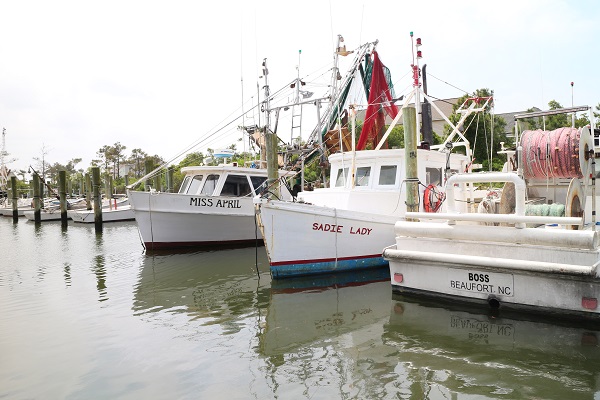Otolith IDs: Tracing Elements of Prime Habitat

John Mohan, a graduate student at East Carolina University, checks a probe monitoring the temperature and dissolved oxygen in a tub aboard a boat in Batchelor Bay. In the tub swim some silvery juvenile striped bass that Mohan picked up earlier that morning from the Edenton National Fish Hatchery. Ten are intended for each of two research cages in the bay.
Four weeks prior to this outing, Mohan’s research team placed empty cages — held down with cinder blocks — in Batchelor Bay and in the Alligator, Perquimans and Pasquotank rivers. Two cages were spaced out in each water body. The team wanted the cages to collect a layer of organic material to be a food source for their research subjects.
Along with commercial fisherman Willy Phillips and biologist Roger Rulifson, on faculty at ECU and director of the Field Station for Coastal Studies at Mattamuskeet, Mohan is looking at traditional striped bass nursery habitats and whether land use and development along Albemarle Sound may be changing how the fish use these areas. The project is sponsored by the North Carolina Fishery Resource Grant Program (FRG) — funded by the N.C. General Assembly and administered by North Carolina Sea Grant.
“John is trying to determine if urbanization is affecting where they [the fish] are and if they are having to move to less desirable nursery habitats,” Rulifson says.
Past research by Rulifson and others has shown the value of using the inner earbones of fish — called otoliths — to trace them back to specific water masses.
The idea is that bodies of water contain unique concentrations of trace elements like strontium, magnesium and calcium that distinguish specific waters from other locations. By analyzing the elements in the water and the otolith of a fish, researchers can then match a particular fish with its birthplace and specific habitats where it lived.
The team will examine otoliths, test water quality and look at land-use maps of surrounding areas to compare the ability of each study location to support healthy growth of striped bass stocks.
Back in Batchelor Bay, Mohan peers through binoculars, scanning the shore for one of the cages, which he suspects has been dislodged by Tropical Storm Hanna. Although he has found the white buoys identifying the cage’s original placement, the 7-foot diameter cylindrical cage is no longer attached.
Mac Bishop, who works for Phillips, guides the boat gingerly around crab pots and bald cypress trees so Mohan can get a closer look at the shore, but the cage is nowhere in sight.
Mohan and Bishop barely flinch as it starts to rain heavily, soaking everything on the boat. They continue with their thorough routine of collecting water samples and measuring water quality and temperature at the surface and bottom with a multi-parameter probe. Mohan is glad his paper and pencil are waterproof as he records data.
Anchoring the boat, they get into the water and pull a beach seine into shore to collect wild striped bass. Back on board, they pull an otter trawl behind the boat and then sift through the catch for more research subjects. Throughout the week, they will repeat this routine at the other research sites.
[ HISTORIC HOMES ]
Striped bass were chosen for the otolith study because their traditional nursery habitats are already well known. Pinning down specific sites was a joint effort by researchers, fishery managers and fishermen.
“It was a combination of John contacting the N.C. Division of Marine Fisheries to see where they had sampled in the past, and relying on local fishermen’s recommendations of where juvenile populations were likely to be,” Phillips says.
Common knowledge says that after hatching in rivers, striped bass go downriver to feed, into places like Batchelor Bay, and move into parts of the eastern Albemarle Sound as they grow. The team wants to test this theory of how striped bass and other species move, considering the possibility that their ways may be changing in response to increased human influence on regional water quality.
For example, striped bass may now prefer to stay in the rivers instead of moving into the sound.
“There are paradigms of populations and species, but there is a lot of individuality,” Rulifson says. “If water itself has a unique signature of elements, we should be able to tell where these fish are staying.”
Phillips, who owns Full Circle Crab Co. in Columbia, explains how stocks within species can vary.
“From the crab world, we know that distinct shapes, colors and meat come from different parts of the ecosystem,” Phillips explains.
Rulifson says the same is true for striped bass. Factors specific to each ecosystem, like toxic material or a flooding event, can affect the size, health and other physical characteristics of the fish living there.
The state’s Coastal Habitat Protection Plan states the need to identify “Strategic Habitat Areas” (SHAs) — locations providing exceptional habitat or that are particularly threatened, vulnerable or rare. If juvenile striped bass are favoring habitats other than fishery managers thought, these habitats may need to be classified differently and managed accordingly.
“We want to compare growth rates of fish in different rivers, which would indicate prime habitat,” Mohan says.
They will also examine the otoliths to see if fish born in the study areas are using traditional habitats associated with their age class, or shifting to other areas.
“Looking at what an individual fish does lets us look at why,” Rulifson explains. “A big reason why fish will leave an area is poor water quality.”
The results will help the team rank their four research sites in terms of habitat value and help to make management recommendations based on findings specific to each area.
[ MICROCHEMISTRY METHODS ]
Rulifson has worked on a number of other FRG projects and has used otoliths to study striped bass since 1994. He describes the rings of an otolith as similar to growth rings on a tree, but even more accurate for predicting age.
“The otolith records the life history of a fish every minute of every day,” he explains. Each day the fish ages, its otoliths incorporate minerals from the water, forming tiny rings that can reveal two things to scientists: the fish’s age, and the chemical conditions of the water it lived in at varying life stages.
Mohan needs to know both criteria. Fish have two otoliths, so he used one to measure age and the other for chemical composition analysis.
The first thing the researchers did for their study was to set up an experimental control, to validate past research showing that otolith chemistry offish matches the water chemistry where they live.
Mohan collected water samples from each of the study locations and tested them for chemical element concentrations.
“We were looking for unique signatures in these locations,” Mohan explains.
Then came the cages. After placing the eight cages in August 2008 — two in each location — and leaving them for four weeks, Mohan introduced 10 hatchery striped bass to each cage and left them to grow through October, when he recollected them for otolith analysis, along with the wild fish caught by trawl and beach seine in each area.
After recording the size of each fish, Mohan removed the otoliths from the brain cavity, embedded them in an epoxy resin, and used a small diamond-bladed saw to cut a thin slice. He then polished each slice with a fine polishing paper and read the daily rings to age the fish.
For the next step, Mohan placed the thin slices on microscope slides for a microchemistry procedure called laser ablation inductively coupled plasma mass spectroscopy – LA-ICP-MS.
This method — focusing a laser beam on a one-millimeter slice of otolith and analyzing the vaporized chemicals that burn off — is as complicated as it sounds, but the results give an extremely detailed timeline of the fish’s life.
The LA-ICP-MS technique is in demand from researchers of a variety of fish species, but only a few laboratories have the necessary equipment. Mohan sent his samples to the University of Manitoba in Canada for analysis.
Once the results are in, the team will compare the elemental analyses and growth rates offish from the different nursery habitats with land-use and development patterns on the adjacent shores using geographical information system (CIS) maps.
[ SHIFTING STRATEGIES ]
If the team discovers that striped bass are using these habitats as traditionally thought, the paradigm will remain for now.
But if the project results show a shift, this research will help identify habitat areas that may need protective management measures. Rulifson offers some strategies to help ensure that nursery habitats remain healthy.
“Buffers could be put in, preventing nutrients from going directly into rivers,” he suggests. Or, a marsh could be used to accumulate nutrients prior to entry into the waterway.
Shifts also may be occurring in other traditional fisheries.
“This study is transferable to a lot of other species we harvest,” Phillips says.
The varying success of restocking efforts for American shad, river herring and hickory shad may indicate that environmental factors are a variable that needs to be considered in those fisheries as well, Rulifson explains.
For more information on FRG projects, go online to ncseagrant.ncsu.edu and follow links to funding opportunities.
To learn more about the state’s Coastal Habitat Protection Plan, visit http://portal.ncdenr.org/web/mf/ and click on “CHPPs.”
This article was published in the Winter 2009 issue of Coastwatch.
For contact information and reprint requests, visit ncseagrant.ncsu.edu/coastwatch/contact/.
- Categories:


